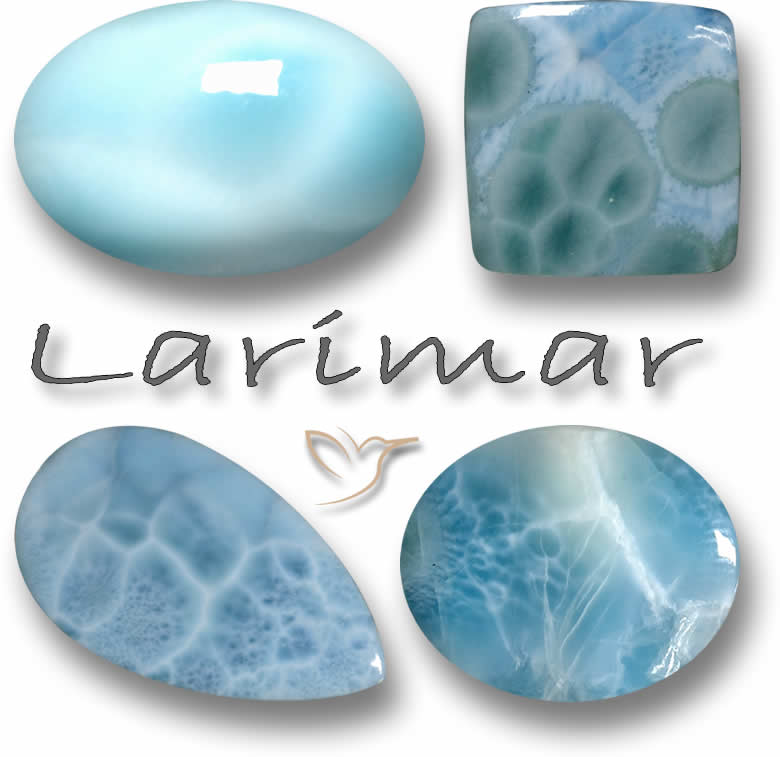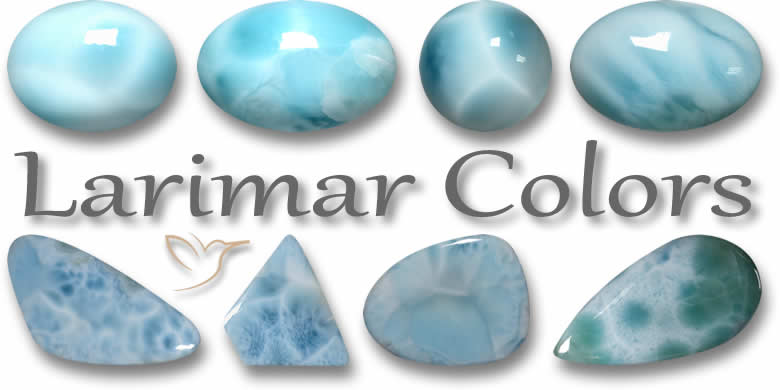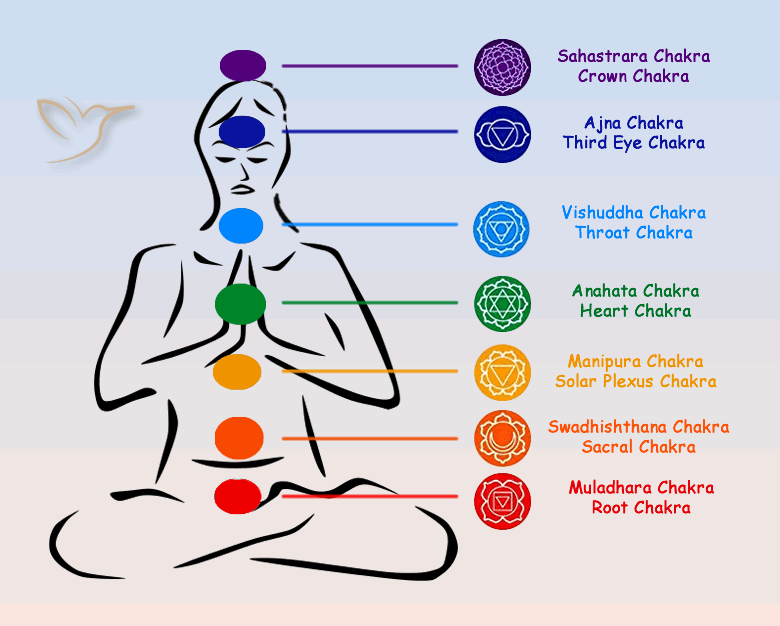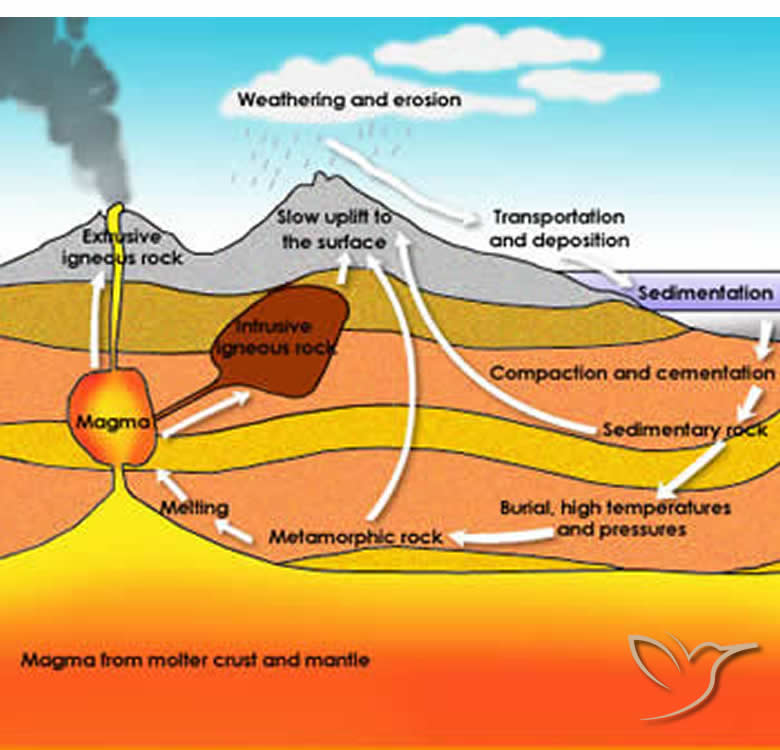What can I find in this article?
- Larimar Colors
- Larimar Species
- Larimar Clarity and Cut
- What is the spiritual meaning of Larimar?
- Larimar and the Chakras
- Health Benefits of Larimar
- Larimar Price
- Larimar Discovery and History
- Where is Larimar found?
- How is Larimar formed?
- Can Larimar be treated?
- What Jewelry is Larimar suitable for?
- Did you know? Fascinating facts about Larimar
- How to care for Larimar
- How can you tell a real Larimar?
- Can Larimar change color?
- What is so special about Larimar?
- Larimar - Gemological Properties
Larimar Gemstone Information

Introduction
Larimar is an exquisite turquoise to teal blue colored gemstone that perfectly reflects the inviting waters of the Caribbean Sea which was once thought to be their source. Of course they did not really come from the ocean but instead they are found deep within the jungle clad volcanic mountains of the Dominican Republic.
Larimar are relatively new on the gemstone market and are only found in one small corner of the world, the famed island of Hispaniola, which the Dominican Republic shares with its neighbor, Haiti.
The story of its discovery as well as how it got its name has added to the natural charms of this gemstone to make it very much sought after.
This gemstone was first reported just over a century ago by Father Miguel Domingo who came across them strewn across the white sandy beaches while taking his early morning walk. This gave rise to the belief that they washed up from the depths of the oceans. Not much notice was taken of the priest or the gemstones for another 50 years until a local jewelry craftsman, Miguel Mendez, was given one to work with. He recognized the gemstone’s natural beauty and potential and was determined to find its source.

The best quality Larimar has a dark blue color with white cloud-like swirls although sky blue coloring can be equally as beautiful and desired.
This stunning gemstone really does look like a summer’s sky dappled with wispy cirrus cloud formations.
Larimar with green, brown or red streaks or spots due to the presence of other minerals or oxidization also exists. This usually detracts from its valuation unless some interesting patterns or pictures and scenes appear.
Larimar is a blue variety of the mineral pectolite, a sodium calcium hydroxide with an unusual fibrous crystal make-up. Common pectolite is found throughout the world but is rarely used as a gemstone because it is too soft and fragile to be cut.
Blue pectolite has densely packed and entwined crystals enabling it to be strong enough to be used as a gemstone with copper impurities causing the delicate turquoise to teal coloring. This blue variety is marketed under the trade name Larimar and is only found in the Caribbean country of the Dominican Republic.
Interestingly an apple green to jade green variety of pectolite has been located on the beaches of California and Alaska but the source of these potential gemstones has yet to be discovered.

Gemstones usually fall into one of three categories of clarity with variations within that category. Opaque gemstones do not allow any light to pass through even if you hold it up to a light source. Translucent gemstones allow some light to shine through but you cannot clearly see through the gemstone. Transparent Gemstones allow light to pass through uninhibited so you can look through them and see objects or read words on the other side.
Larimar is an opaque gemstone although patches of translucent material can be present. As such it is usually cut and polished into cabochon or dome shapes to show off the blue colors and cloud-like patterns.
The cabochons are customarily ovals, circles, pears or rectangles but occasionally they can be cut into irregular or odd shapes to enhance a particularly bewitching color scheme or capture an enchanting pattern. These are ideal for making one-of-a-kind pieces of jewelry.
Pectolite was first described in the 1800s after its discovery in the Italian Alps while the blue variety was only noted in 1916 and it was not until 1974 that Larimar was given its name and sold as a gemstone. Given its recent history, Larimar’s spiritual powers are not yet fully understood and appreciated by even the most experienced crystal authorities.
That being said its resonance with the waters of the ocean and the rivers is undoubted and its efficacy as a gemstone of relaxation and stress relief is well established. It is an ideal gemstone for use with meditation and is the perfect bath companion – either in the soothing waters with you or placed by the side of the tub with some scented candles and essential oils.
Linked to its ability to relieve stress, Larimar can help deal with many types of irrational phobias. The fear of flying can be very restrictive in this day and age and anecdotal reports have suggested that this gemstone can comfort you if you have no alternative but to fly.

Chakras are the energy centers in your body also known as Qi or Prana. There are seven Chakras throughout the body each influencing a particular physical, emotional or mental state and each has an associated color. The seven chakras are as follows, Crown linked with the color purple, Third Eye (indigo), Throat (blue), Heart (green), Solar Plexus (yellow), Sacral (orange) and Root (red). Depending on which color is most dominant in your larimar gemstone will determine which chakra it will have most influence on.
With its blue coloring it will come as no surprise that Larimar is connected to the Throat Chakra and on a physical level it will help relieve sore throats, coughs, tonsillitis, toothache, tension headaches, stiff necks and thyroid problems.
One of the greatest fears we have is the fear of public speaking (although spiders are much scarier) and Larimar is the perfect gemstone to help you overcome shyness and anxiety if you have to give a speech or make a presentation.
Communication is vital for contentment at home and success at work. With its special relationship to the Throat Chakra, Larimar will allow you to express yourself to friends, family and your partner in a clear and easily understood manner. On the employment front, this gemstone can help you reach out to colleagues and articulate your needs to your superiors.
We all know that stress is a major problem in the modern world and has been referred to as a silent killer. It may be an emotional issue but leads to many physical illnesses. Larimar as a calming and soothing gemstone will ease the feelings of stress which will in turn help the whole body holistically.
Perhaps it is the life-giving force of the water that first gave us Larimar gemstones which makes it a kindred spirit to mothers. It can help mothers-to-be cope with morning sickness, help fight labor pains during birth and fend off the possibility of post natal depression.
We are often asked how to use gemstones for spiritual or health benefits and while we are certainly not experts in this field we have gained some experience and knowledge. Of course wearing the gemstone as a piece of jewelry is the easiest way for the crystal to influence your body. As a gemstone of the Throat Chakra, Larimar would be perfect as a pendant, necklace or earrings.
Alternatively they can be placed in your purse or pocket and used as a touchstone throughout the day. Hold crystals or place them in your lap while meditating. Easiest of all, just lay down with crystals on your body, lined up with the chakra points if possible.
Larimar should be cleansed every few weeks to keep it at its maximum potential. You can do this by running the stone under tepid water and drying it with a soft cloth. It is best not to let your Larimar gemstone dry in the sun as long exposure can lead to fading.
Larimar Price List |
||
Color |
Weight range |
Price range / USD |
|---|---|---|
Blue / Green |
1ct + |
$2 - 10/ct |
Larimar is a rare and beautiful gemstone and this is reflected in the price. It has only one source and this source is deep in the mountainous jungles of the Dominican Republic where miners dig them by hand in hot humid conditions. Half the year is often lost to heavy rains, hurricanes and mud slides and it is estimated only 10% of the rough stones make it to finished gemstones.
It might seem a miracle we get any Larimar gemstone at all! Once the rough stones have been prized from the walls of the mineshafts hundreds of feet into the hills in the province of Barahona they are taken to the local village where the miners’ families sort them before sending them on to be cut and polished.
The price of Larimar depends first of all on the color with deep blue being the most valuable color – sometimes confusingly called Volcano Blue. This deep blue to an almost sky blue with light white marbling is the most expensive gemstone.
An all blue Larimar with white swirls and wisps is the ideal but other gemstones may have other spots or stains on part of the gemstone. This will lower the price depending on the size and color of the impurity.
As there is only one known source of Larimar there are always rumors of the mine soon being exhausted, this may possibly be true but do not be pressurized into paying excessive prices because ‘next year it’ll all be gone’.

Discovering a precious gemstone must be an amazing thing and of course all gemstones must have been discovered by someone somewhere at sometime. In very few cases can we put a name to the person, the discoverers of Tanzanite, Tsavorite and Kunzite spring to mind but Larimar has a wonderfully detailed history of discovery.
The island of Hispaniola was given its name by Christopher Columbus and was the site of the first European settlement in the Americas (I am not sure if you can include the Vikings in Greenland). The island is divided between two countries, Haiti and the Dominican Republic.
In 1916 a priest, Father Miguel Domingo Fuertes Loren was taking his morning walk along the beach when he spotted several rocks in the sand. When he asked the locals about them he was told that they were gifts from the sea. This was no ordinary priest but a naturalist (with 35 species of plant named after him) and amateur geologist.
Father Miguel tried to investigate further but never found the true source of these ‘blue stones’ and the story could have ended there. Sixty years later Miguel Mendoza was sitting in his craft shop where he made and sold little pieces of jewelry to tourists. A customer brought in a rough blue gemstone and asked him to make a bracelet for her. Miguel asked here where she got the gemstones and she told him Barahona Beach.
Intrigued, Miguel and his friend from the Peace Corp, amateur geologist, Norman Rilling took a trip out to see if they could find some more. Local fishermen told the pair that you could always find these blue stones on the beach and that they washed ashore all the time. Realizing it was more likely that the gemstones would be carried downstream from the nearby mountains the two men searched and discovered the source 10km inland.
Further investigation led to it being identified as a variety of pectolite but it is hardly a name that reflects such a splendid stone with its blues so evocative of the Caribbean seas. Miguel gave it some thought and came up with Larimar – ‘Lari’ from his daughter’s name Larissa and ‘mar’ meaning sea in Spanish.
The government of the Dominican Republic gave the mining rights to the local people of the province and they must at least be part owners of any mine. The locals do the mining and sorting and sell to jewelers who then make items to be sold to the many tourists who travel to this part of the world.
So there you have it, the complete story of discovering, naming and marketing of this remarkable gemstone. If only we had the story of the first person to find a sapphire!

Larimar, the blue pectolite, is found in only one location in the world – the Filipinas Mine in Los Checheses in the Province of Barahona in the Dominican Republic. You really cannot get any more precise than that.
Most Larimar began to form around 100 million years ago when the islands of the Caribbean were created by tectonic movement and volcanic eruptions.

Hot molten rock rose to the surface crust of the earth and began to cool. Within the soft, warm lava gas bubbles formed as well as cracks and cavities where lava flows overlapped or cooled at different rates. The lava hardened into rock and the gasses escaped leaving little pockets of space.
Into these pockets, fluids containing silica, calcium and sodium flowed and settled. Over time these fluids crystallize into the gemstones we all love. In the case of Larimar the crystals had trace impurities of copper mixed in with the basic composition which gave us the blue color.
As far as we are aware, Larimar is not treated in any way to enhance its color or beauty other than the usual cutting and polishing of the initial rough gemstones.
If any gemstones sold by GemSelect receive treatment we will always disclose this information.
As a rare and stunning gemstone, Larimar is perfect for jewelry but a few things need to be considered first. Larimar is rated at only 4.5 – 5 on the Mohs hardness scale which makes it relatively soft for a gemstone. However the blue part of the gemstone is much harder than the white part so look out for bluer specimens.
See our detailed article on the Mohs hardness scale right here
As it can be so soft we would recommend protective settings for rings and bracelets but there should be no problem using Larimar in pendants, necklaces and earrings.
Larimar can come in some lovely large carat sizes and some very interesting shapes for unique jewelry but we always recommend buying gemstones on physical size not carat size. If you order a gemstones 15mm x 12mm x 6 mm you will know exactly what to expect rather than a 12ct gem.
- Apart from Amber, Larimar is the only gemstone found in the entire Caribbean.
- Other names for Larimar include Stefilia’s Stone, Atlantis Stone and Dolphin Stone.
- Los Chupaderos is a single mountainside with 2000 mining shafts dug by hand over the past 40 years in the search for Larimar.
- Larimar is rated 4.5 to 5 on the Mohs hardness scale but deep blue sections on the gemstone can be rated as high as 7.
As with most gemstones, you should not use any household chemicals or solvents when caring for or cleaning your gemstone pieces as Larimar is particularly sensitive to chemicals. Larimar should not be exposed to prolonged periods of sunlight as it may cause permanent damage to the gemstone.
We do not recommend using steam or ultra sonic cleaners just a soft brush and warm soapy water and then dried with a soft cloth.
Your gemstones should be stored inside a fabric-lined box or wrapped in a soft cloth and Larimar should be kept away from other gemstones and jewelry to ensure it does not get scratched by other harder gemstones.
Larimar is rated 4.5 – 5 on Mohs hardness scale so is considered quite soft for a gemstone. We would recommend removing Larimar jewelry when engaging in any sort of physical activity such as sports, gardening, household cleaning and so on.

Obviously buying gemstones from a reputable dealer is the best approach but this is not always possible when you are out searching the net or scouring the stores for a great gemstone or a bargain!
This is not a complete guide on how to spot a real gemstone but I hope it helps.
Larimar is a quite distinctive blue to green gemstone with interconnecting white swirls and patterns so it is worth taking a look at some real examples either in person or on the internet to familiarize yourself as to what it is supposed to look like.
Anything that has a very startling blue color should be treated with suspicion and very clean, ‘too good to be true’ examples with no imperfections should also be investigated carefully. Look for white streaks as all Larimar should have some.
Larimar is opaque so if you can hold it up to light check that no light comes through – even at the edges as this could be an indicator of painted glass.
Check the price, Larimar is rare and expensive so anything cheap should be suspected.
The burn test. Larimar will not be permanently damaged by exposure to a naked flame so vendors around the tourists spots of the Dominican Republic will often hold their lighters up to a Larimar gemstone to prove it is real. This will prove it is not plastic but it is more a trick than a test. (PS please don’t start burning gemstones at your local store without asking first!)
The scratch test. Larimar is rated as 4.5 – 5 on the Mohs Scale so can be scratched by a knife or by a iron nail. Checking this can be difficult because if you scratch one that it is real you have just damaged a rare gemstone! If you do try and cannot scratch it then it is likely to be dyed quartz. Again do not do it without permission.
There are several dyed Larimar gemstones available and so long as they are clearly indicated we have no problem with it. The same goes with imitation Larimar, so long as it is clearly marked. GemSelect only sell genuine, un-dyed Larimar gemstones.
At GemSelect, we stand by our gemstones as being as we describe them, any treatments are disclosed and our return policy means you can feel quite assured when ordering from us.
At GemSelect, we currently offer brief identification reports from your choice of two well-respected independent gemological laboratories, The Asian Institute of Gemological Sciences (AIGS) and Burapha Gemological Laboratory (BGL Lab).

Some gemstones show a distinct or dramatic change in color under different light sources. Look at a garnet under electric or artificial light and it could look red, take it outside into the sunlight and all of a sudden it is green! This remarkable effect only occurs in a few gemstones, Alexandrite, Garnet and some Sapphires being the most well known but does NOT occur in Larimar.
There is nothing new under the sun, the saying goes, and with the natural world this seems to be quite true, we have found, studied and classified just about every animal, plant and mineral there is. Every now and then, however, something special emerges from a quiet corner to surprise us all. Larimar gemstones are that special surprise, a recent gift from Mother Nature, originally noted in the 20th century, first mined less than 50 years ago and found in only one location on earth.
The Caribbean is not renowned for its gemstones, but instead is well known for its white sandy beaches, azure seas, clear blue skies, vibrant music and welcoming friendly people. Since nature decided to only give this region one gemstone, it decided it would have to encapsulate the essence of Caribbean culture.
Each gemstones displays a unique vision of the skies and the ocean, they are lively and fun, captivating and diverting, looking at a Larimar is guaranteed to lighten your day and bring a smile to your lips.
Chemical Formula: |
NaCa2Si3O8(OH) |
Crystal Structure: |
Triclinic pinacoidal |
Color: |
White, blue, green-blue, multicolored |
Hardness: |
Typically 4.5 to 5 (up to 6 for some finely fibrous material) |
Refractive Index: |
1.59 to 1.65 |
Density: |
2.70 - 2.90 |
Cleavage: |
Perfect |
Transparency: |
Translucent to opaque |
Double Refraction or Birefringence: |
0.038 |
Luster: |
Silky |
Fluorescence: |
Weak: Green |

